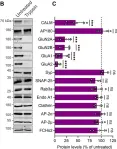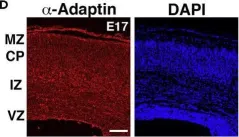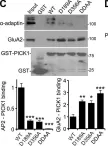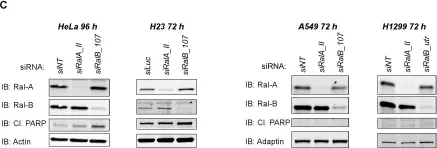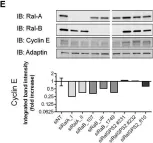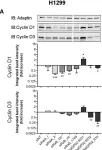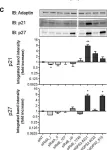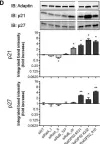GTPases regulate various cellular processes through conformational changes triggered by GTP or GDP binding. Recently, pseudoGTPases, the catalytically inactive counterparts of GTPases, have been identified across species from bacteria to human, although their functions and mechanisms remain unexplored. In this study, we demonstrate that the N-terminal region of the assembly chaperone AAGAB is a type i pseudoGTPase using biochemistry and X-ray crystallography. Furthermore, we discovered that the AAGAB pseudoGTPase domain (psGD) interacts with the σ subunits of AP1 and AP2 adaptor complexes, heterotetrameric complexes involved in clathrin-mediated membrane trafficking. AAGAB psGD engages the σ subunits via a unique interface distinct from the conventional GTPase interacting regions. Further biochemical and cell-based assays confirmed the crucial role of the newly identified interface in binding and membrane trafficking. Collectively, our results establish AAGAB pseudoGTPase domain as a critical protein-protein interaction module. These findings offer new insight into the structural basis and molecular mechanisms of pseudoGTPases. Highlights AAGAB N-terminal region is a pseudoGTPase AAGAB pseudoGTPase domain interacts with and stabilizes AP1 and AP2 σ subunits The crystal structure of AAGAB psGD:AP1σ3 is the first reported psGD complex structure, revealing a unique interface independent of guanine nucleotide regulation The psGD:AP1σ3 structure offers mechanistic insights into σ subunits stabilization and protection through adaptor complex assembly
Product Citations: 41
Structural basis of pseudoGTPase-mediated protein-protein interactions
Preprint on BioRxiv : the Preprint Server for Biology on 1 November 2024 by Wang, B., Yang, R., et al.
Apache is a neuronal player in autophagy required for retrograde axonal transport of autophagosomes.
In Cellular and Molecular Life Sciences : CMLS on 5 October 2024 by Parisi, B., Esposito, A., et al.
Neurons are dependent on efficient quality control mechanisms to maintain cellular homeostasis and function due to their polarization and long-life span. Autophagy is a lysosomal degradative pathway that provides nutrients during starvation and recycles damaged and/or aged proteins and organelles. In neurons, autophagosomes constitutively form in distal axons and at synapses and are trafficked retrogradely to the cell soma to fuse with lysosomes for cargo degradation. How the neuronal autophagy pathway is organized and controlled remains poorly understood. Several presynaptic endocytic proteins have been shown to regulate both synaptic vesicle recycling and autophagy. Here, by combining electron, fluorescence, and live imaging microscopy with biochemical analysis, we show that the neuron-specific protein APache, a presynaptic AP-2 interactor, functions in neurons as an important player in the autophagy process, regulating the retrograde transport of autophagosomes. We found that APache colocalizes and co-traffics with autophagosomes in primary cortical neurons and that induction of autophagy by mTOR inhibition increases LC3 and APache protein levels at synaptic boutons. APache silencing causes a blockade of autophagic flux preventing the clearance of p62/SQSTM1, leading to a severe accumulation of autophagosomes and amphisomes at synaptic terminals and along neurites due to defective retrograde transport of TrkB-containing signaling amphisomes along the axons. Together, our data identify APache as a regulator of the autophagic cycle, potentially in cooperation with AP-2, and hypothesize that its dysfunctions contribute to the early synaptic impairments in neurodegenerative conditions associated with impaired autophagy.
© 2024. The Author(s).
-
Biochemistry and Molecular biology
-
Cell Biology
An AAGAB-to-CCDC32 handover mechanism controls the assembly of the AP2 adaptor complex.
In Proceedings of the National Academy of Sciences of the United States of America on 20 August 2024 by Wan, C., Puscher, H., et al.
Vesicular transport relies on multimeric trafficking complexes to capture cargo and drive vesicle budding and fusion. Faithful assembly of the trafficking complexes is essential to their functions but remains largely unexplored. Assembly of AP2 adaptor, a heterotetrameric protein complex regulating clathrin-mediated endocytosis, is assisted by the chaperone AAGAB. Here, we found that AAGAB initiates AP2 assembly by stabilizing its α and σ2 subunits, but the AAGAB:α:σ2 complex cannot recruit additional AP2 subunits. We identified CCDC32 as another chaperone regulating AP2 assembly. CCDC32 recognizes the AAGAB:α:σ2 complex, and its binding leads to the formation of an α:σ2:CCDC32 ternary complex. The α:σ2:CCDC32 complex serves as a template that sequentially recruits the µ2 and β2 subunits of AP2 to complete AP2 assembly, accompanied by CCDC32 release. The AP2-regulating function of CCDC32 is disrupted by a disease-causing mutation. These findings demonstrate that AP2 is assembled by a handover mechanism switching from AAGAB-based initiation complexes to CCDC32-based template complexes. A similar mechanism may govern the assembly of other trafficking complexes exhibiting the same configuration as AP2.
-
WB
Regulation of cargo exocytosis by a Reps1-Ralbp1-RalA module.
In Science Advances on 22 February 2023 by Wang, S., Chen, X., et al.
Surface levels of membrane proteins are determined by a dynamic balance between exocytosis-mediated surface delivery and endocytosis-dependent retrieval from the cell surface. Imbalances in surface protein levels perturb surface protein homeostasis and cause major forms of human disease such as type 2 diabetes and neurological disorders. Here, we found a Reps1-Ralbp1-RalA module in the exocytic pathway broadly regulating surface protein levels. Reps1 and Ralbp1 form a binary complex that recognizes RalA, a vesicle-bound small guanosine triphosphatases (GTPase) promoting exocytosis through interacting with the exocyst complex. RalA binding results in Reps1 release and formation of a Ralbp1-RalA binary complex. Ralbp1 selectively recognizes GTP-bound RalA but is not a RalA effector. Instead, Ralbp1 binding maintains RalA in an active GTP-bound state. These studies uncovered a segment in the exocytic pathway and, more broadly, revealed a previously unrecognized regulatory mechanism for small GTPases, GTP state stabilization.
-
WB
Oligomer-to-monomer transition underlies the chaperone function of AAGAB in AP1/AP2 assembly.
In Proceedings of the National Academy of Sciences of the United States of America on 10 January 2023 by Tian, Y., Datta, I., et al.
Assembly of protein complexes is facilitated by assembly chaperones. Alpha and gamma adaptin-binding protein (AAGAB) is a chaperone governing the assembly of the heterotetrameric adaptor complexes 1 and 2 (AP1 and AP2) involved in clathrin-mediated membrane trafficking. Here, we found that before AP1/2 binding, AAGAB exists as a homodimer. AAGAB dimerization is mediated by its C-terminal domain (CTD), which is critical for AAGAB stability and is missing in mutant proteins found in patients with the skin disease punctate palmoplantar keratoderma type 1 (PPKP1). We solved the crystal structure of the dimerization-mediating CTD, revealing an antiparallel dimer of bent helices. Interestingly, AAGAB uses the same CTD to recognize and stabilize the γ subunit in the AP1 complex and the α subunit in the AP2 complex, forming binary complexes containing only one copy of AAGAB. These findings demonstrate a dual role of CTD in stabilizing resting AAGAB and binding to substrates, providing a molecular explanation for disease-causing AAGAB mutations. The oligomerization state transition mechanism may also underlie the functions of other assembly chaperones.
-
WB
In Sci Adv on 27 May 2022 by Tehran, D. A., Kochlamazashvili, G., et al.
Fig.1.B

-
WB
-
Collected and cropped from Sci Adv by CiteAb, provided under a CC-BY license
Image 1 of 11
In Cells on 26 October 2021 by Sousa, D., Lima, R. T., et al.
Fig.1.B

-
WB
-
Collected and cropped from Cells by CiteAb, provided under a CC-BY license
Image 1 of 11
In iScience on 28 September 2018 by Shikanai, M., Nishimura, Y. V., et al.
Fig.1.D

-
IHC-IF
-
Mus musculus (House mouse)
Collected and cropped from iScience by CiteAb, provided under a CC-BY license
Image 1 of 11
In J Cell Biol on 2 October 2017 by Fiuza, M., Rostosky, C. M., et al.
Fig.6.C

-
WB
-
Rattus norvegicus (Rat)
Collected and cropped from J Cell Biol by CiteAb, provided under a CC-BY license
Image 1 of 11
In PLoS One on 7 May 2016 by Santos, A. O., Parrini, M. C., et al.
Fig.3.C

-
WB
-
Collected and cropped from PLoS One by CiteAb, provided under a CC-BY license
Image 1 of 11
In PLoS One on 7 May 2016 by Santos, A. O., Parrini, M. C., et al.
Fig.6.E

-
WB
-
Collected and cropped from PLoS One by CiteAb, provided under a CC-BY license
Image 1 of 11
In PLoS One on 7 May 2016 by Santos, A. O., Parrini, M. C., et al.
Fig.6.F

-
WB
-
Collected and cropped from PLoS One by CiteAb, provided under a CC-BY license
Image 1 of 11
In PLoS One on 7 May 2016 by Santos, A. O., Parrini, M. C., et al.
Fig.6.B

-
WB
-
Collected and cropped from PLoS One by CiteAb, provided under a CC-BY license
Image 1 of 11
In PLoS One on 7 May 2016 by Santos, A. O., Parrini, M. C., et al.
Fig.6.A

-
WB
-
Collected and cropped from PLoS One by CiteAb, provided under a CC-BY license
Image 1 of 11
In PLoS One on 7 May 2016 by Santos, A. O., Parrini, M. C., et al.
Fig.6.C

-
WB
-
Collected and cropped from PLoS One by CiteAb, provided under a CC-BY license
Image 1 of 11
In PLoS One on 7 May 2016 by Santos, A. O., Parrini, M. C., et al.
Fig.6.D

-
WB
-
Collected and cropped from PLoS One by CiteAb, provided under a CC-BY license
Image 1 of 11
